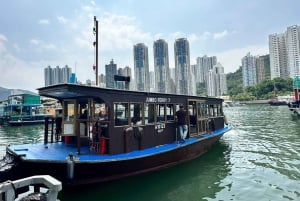Place to Eat
Hong Kong is well known for shopping and everyone think this is the city's 'big thing', but dining is another activity that we cannot miss either. You may top off a shopping expedition to Stanley Market with a tasty meal or drink, or a first class dinner at a top floor restaurant with nice views of Hong Kong. Another important meal that needs a mention is dim sum at a noisy Cantonese restaurant. You don't have to spend a lot of money because there are many reasonably priced establishments which allow you to dine well. Many consider Hong Kong to have the greatest concentration of Chinese restaurants in the world.
Food
Local Delicacies:
1. Dim sum: one of the most important elements of Chinese traditional food is dim sum (general introduction of the food, and a more detailed
Dim Sum is a Cantonese term for a type of meal that involves small individual portions of food, each having its unique taste and shape. In the past, it is usually being pushed around on carts by servers, but nowadays, this tradition has changed a little, due to limited area that each restaurant has, most of the restaurants end up using order sheets. The few dishes that must be ordered are:
- Har Gau (prawns dumpling)
- Siu mai (steamed mince and prawn dumplings decorated with bright orange crab eggs)
- Cheung fen (soft white rice flour rolls sloshed with soy)—there are a variety of cheung fens, such as sweet pork, meat and prawns.
- Luo buo gau (fried squares of turnip, pork and mushroom mash)
- Char siu bao(sweet pork bun)
All of these dishes are also recommended to those who are spicy lovers to eat with hot sauce or XO sauce, which makes the food that much better.
2. Chinese desserts: dou fu fa; zhi ma wu; moon cake etc
3. Cha chan teng : Tsui wah
As a local Hong Kong-nese, we spend most of our meals either at home or at "Cha Chan Tengs", it’s a place where people drop in for breakfast, lunch, tea or dinner to get a filling meal cheaply and quickly. These small individual restaurants offer a large variety of food, from noodles to rice; coffee to ice tea, all kinds of food can be found on the menu. My personal favorite Sunday morning breakfast would be going to a Cha Chateng after church and order a set A meal (usually the same thing across all Cha Chantengs), it includes eggs, sausage or ham, a toast, a noodle and a drink, which only cost 21~23 dollars, but keeps me awake and pleasant for the rest of the day. It is very Hong Kong, so there’s bound to be one close to wherever you go. Out of all the Cha Chantengs, "Tsui Wah" and "Australia Dairy Company" are two of the most famous ones, having thousands of people visiting every single day, serving the most delicious food at the cheapest price. Once I met this lady on the place when I was going to Shanghai, and the first thing she said to me was how good the food in "Tsui Wah" was, at that moment, I had nothing else but pride in my heart.
4. Street snacks (a brief description of each kind of food, places will not be mentioned, note the hygiene problem)—include different kinds of street drinks, compare it to Thailand
Similar to Cha Chantengs, street snacks also has its own importance in the culture of Hong Kong food, which it includes mostly deep fried and spicy food, and all having a unique taste. Street snacks include fish balls, siu mai (slightly different from the Yum Cha "siu mai", which as a street snack, it doesn’t include any prawns in it), cow internal organs (from small intestine and large intestines, to kidney and lungs), squid in curry sauce, etc.
Apart from food, a lot of street snacks also supply take-away freshly made juice, which is being custom by you, with your own choice of all your favourite fruits being juiced and handed to you in a cost between 5~10 dollars. Other common drinks found at stalls around Hong Kong include herbal/health teas, soya milk and bubble tea that contain fruit juice and pulp, sago, coconut milk, grass jelly, red beans, ice and jellied candy. It is arguably the best thing you can have when it is 34ºC out there, and you have salty sweat dripping down both sides of your cheek, the sweetness of the drinks going down your throat allows you to understand the meaning of paradise.
5. Chinese medicine shops, hung fuk tong, introduce turtle jelly; coughing tea; five flower tea; etc
6. Main stream restaurants: Tai Ping Koon; Luk Yu Tea House; Yung Kee—describe the higher priced food, including bird’s nest soup; shark fin soup and abalone.
7. Seafood: Sai Kung; Lei Yue Mun; Po Toi Island; Lama Island. (Each location, and specifically mention Limulidae鱟)
8. Wet-market (family comes first, and nothing is as important as having dinner together, while the husbands spend hours at the office, all the food preparation work comes down to the housewives. Instead of buying it from the Supermarket, the wet market is usually the first pick for most housewives, for its freshness and cheapness. Each day, the wet market starts
9. Daa Laang
Western Food:
Children’s favorite-
1. Ruby Tuesday
2. TGI Friday
3. California Pizza Kitchen
4. Jumbo
Private Dining Restaurants: small-scale, privately run restaurants located unobstructively in residential or commercial blocks—usually only having 2 sittings each evening
1. Yellow door Kitchen
2. Mum Chau’s Sichuan Kitchen
Indian, Italian, Turkish, Japanese (main stream V.S. special ones)
Soho, Central: Small boutique cafes, Ethnic food (Mexican, etc)
Chung King Mansion- Indian Curry, African bistros, etc)











